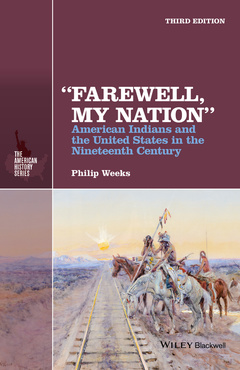Description
"Farewell, My Nation" (3rd Ed.)
American Indians and the United States in the Nineteenth Century
The American History Series
Author: Weeks Philip
Language: English
Subject for "Farewell, My Nation":
Keywords
Native Americans; Indigenous peoples; social anthropology; American history; U.S; history; the Indian question; relocation; reservations; the Plains Wars; Wounded Knee; Sioux; Great Plains; Plains Indians; nineteenth century America; American military history; Americanization; First Nations; American Civil War; Tecumseh; William Tecumseh Sherman; U.S; Army; Closing of the American Frontier; Philip Sheridan; Sitting Bull; Crazy Horse; Santee Sioux Uprising; Battle of Little Bighorn; George Armstrong Custer
Publication date: 02-2016
368 p. · 14.7x22.4 cm · Hardback
Publication date: 02-2016
368 p. · 14x21.3 cm · Paperback
Description
/li>Contents
/li>Readership
/li>Biography
/li>
The fully updated third edition of "Farewell, My Nation" considers the complex and often tragic relationships between American Indians, white Americans, and the U.S. government during the nineteenth century, as the government tried to find ways to deal with social and political questions about how to treat America?s indigenous population.
- Updated to include new scholarship that has appeared since the publication of the second edition as well as additional primary source material
- Examines the cultural and material impact of Western expansion on the indigenous peoples of the United States, guiding the reader through the significant changes in Indian-U.S. policy over the course of the nineteenth century
- Outlines the efficacy and outcomes of the three principal policies toward American Indians undertaken in varying degrees by the U.S. government ? Separation, Concentration, and Americanization ? and interrogates their repercussions
- Provides detailed descriptions, chronology and analysis of the Plains Wars supported by supplementary maps and illustrations
Preface ix
Acknowledgments xi
1 The "Indian Question" 1
In Need of a Solution 1
Breaching the Ohio Country Barrier 7
The Shooting Star and the Prophet 18
2 The Initial Solution 35
The Relocation Debate 35
Tribal Strategies in the South 40
The Cherokee–Georgia Conundrum 46
Removing the Southern Tribes 52
The Indian Territory and Its People 65
Undermining Forces 74
Dashed Hopes 81
3 The Travails of Mid Century 89
Western Troubles and the New Solution 89
Making Way for the Railroads 98
The Texas Challenge 102
Whether or Not to Be a Confederate 108
Civil War in the Indian Territory 117
Unrest in Minnesota 127
Colorado and Sand Creek 137
4 The Plains Wars, Phase I: Realizing Concentration 151
Those Who Resisted: An Inescapable Fate? 153
Indian Policy and Who Controlled It 159
Defending the Powder River Country 166
Dualism: Peace and Force Policies 176
Commotion in Kansas 180
Implementing Concentration 187
With the Olive Branch and the Sword 195
5 The Plains Wars, Phase II: Enforcing Concentration 209
Again, Indian Affairs and Who Controls Them 210
The Grant Peace Policy 214
At the Watershed 221
The Red River War 228
The Peace That Slipped Away 236
The Great Sioux War Commences 246
The Great Sioux War Concludes 259
6 The Search for a New Order 269
Reforms and Jurisdictional Disputes 270
Reappraising the Concentration Policy 279
The Government's Newest "Solution" 293
Ending "Old and Injurious Habits" 301
Americanization: White Rationalizations and Tribal Responses 306
Dead Dreams 314
Bibliographical Essay 326
Index 338




